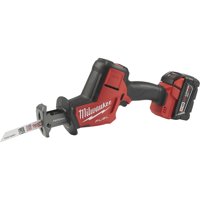I just bought a new battery powered Recipicating saw.
I NEVER thought I'd need one in the Woods.
When I ATV trails the faithful Echo 352 goes along.
My Brother, who can buy a dozen of any saw he desires dropped by to see the Woods I've been underbrushing.
He said I'd enjoy the battery powered Recipicating saw to go along with my small gas chainsaw.
Today my Hitachi repicipating saw arrived and I already had a couple Li-Po batteries charged so to the woods I went.
One thing I liked is, no pulling a rope, much less noise, instant sawing and removing small stuff to get the ATV between the big trees was a snap. BUT, we all know you can't get a chainsaw bar tip in the dirt so we'll were limited.
The Wood cutting (Pruning saw) is probably 10 inches long and cuts right in dirt. No bar oil needed and by using the tip I was able to cut roots at or beneath the ground. If it dulls, buy another, these blades are cheap and no filing necessary.
Saplings as big as a bleach bottle top were easy to remove. Dangerously harp stobs left from the Bush hog that destroy tractor and ATV tires were cut flat near ground level.
This saw DOES NOT cut as fast as a chainsaw but I was able to cut a 2 inch Gum sapling pretty quickly.
I'm going to prune some small limbs with it.
Also I may cut some top limbs after felling a big tree. 1.5 inch stuff is fast and easy and green limbs are easy.
One thing I'm thinking is when the gas saw (and it will if you underbrush often enough) gets pinched on small stuff this saw may be able to clear the chain without hacking with an axe.
I got my saw online at Wallyworld dot com. Two day shipping was free. Less out of pocket than buying at the Jungle river store, no joining nothing. Placed order Under 75 bucks and two days later I'm ready to go cut stuff.
I think a battery powered Recipicating saw may be something to go in my trailer along with a chainsaw. It's to enhance not replace.
Comments appreciated by anyone who actually tries one out in brush.
I'd be interested to know your results.
I have a bunch of corded saws-all's in the shop and my opinion has been they belong in a shop no place for them in the woods. However, the battery powered one with pruning blade may change my opinion.
Good day.
I NEVER thought I'd need one in the Woods.
When I ATV trails the faithful Echo 352 goes along.
My Brother, who can buy a dozen of any saw he desires dropped by to see the Woods I've been underbrushing.
He said I'd enjoy the battery powered Recipicating saw to go along with my small gas chainsaw.
Today my Hitachi repicipating saw arrived and I already had a couple Li-Po batteries charged so to the woods I went.
One thing I liked is, no pulling a rope, much less noise, instant sawing and removing small stuff to get the ATV between the big trees was a snap. BUT, we all know you can't get a chainsaw bar tip in the dirt so we'll were limited.
The Wood cutting (Pruning saw) is probably 10 inches long and cuts right in dirt. No bar oil needed and by using the tip I was able to cut roots at or beneath the ground. If it dulls, buy another, these blades are cheap and no filing necessary.
Saplings as big as a bleach bottle top were easy to remove. Dangerously harp stobs left from the Bush hog that destroy tractor and ATV tires were cut flat near ground level.
This saw DOES NOT cut as fast as a chainsaw but I was able to cut a 2 inch Gum sapling pretty quickly.
I'm going to prune some small limbs with it.
Also I may cut some top limbs after felling a big tree. 1.5 inch stuff is fast and easy and green limbs are easy.
One thing I'm thinking is when the gas saw (and it will if you underbrush often enough) gets pinched on small stuff this saw may be able to clear the chain without hacking with an axe.
I got my saw online at Wallyworld dot com. Two day shipping was free. Less out of pocket than buying at the Jungle river store, no joining nothing. Placed order Under 75 bucks and two days later I'm ready to go cut stuff.
I think a battery powered Recipicating saw may be something to go in my trailer along with a chainsaw. It's to enhance not replace.
Comments appreciated by anyone who actually tries one out in brush.
I'd be interested to know your results.
I have a bunch of corded saws-all's in the shop and my opinion has been they belong in a shop no place for them in the woods. However, the battery powered one with pruning blade may change my opinion.
Good day.





